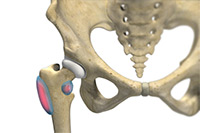Hip Bursitis

What is Hip Bursitis?
Hip bursitis is a painful condition caused by inflammation of a bursa in the hip. Bursae are fluid filled sacs present in joints between bone and soft tissue to reduce friction and provide cushioning during movement.
The bony prominence of the hip is called greater trochanter and is present on the outer side of the upper thighbone or femur. The bursa overlying it is called trochanteric bursa. Another bursa is located towards the groin region and is called iliopsoas bursa. Bursitis of the trochanteric bursa is more common than that of iliopsoas bursa.
Causes of Hip Bursitis
Trochanteric bursitis is often seen in people involved in sports such as football and soccer which involve a lot of running. This can lead to overuse and irritation of the bursa causing inflammation. Bursitis may sometimes result from an injury or fall to the hip or after a surgical procedure of the hip. Spine disease, rheumatoid arthritis and leg length inequality increases the risk for developing hip bursitis.
Symptoms of Hip Bursitis
Trochanteric bursitis results in pain on the outer side of the hip which usually increases with prolonged walking or climbing stairs. The pain is felt more while getting up from a chair and in the night when lying on the affected side. Inflammation of the iliopsoas bursa however results in pain in the groin region.
Diagnosis of Hip Bursitis
Tenderness and swelling in the area of pain over the bursa during the physical examination of the hip confirms the diagnosis of Hip Bursitis. To check for any bone spurs that could be causing irritation of the bursa your doctor may order an X-ray. If the reason for the pain is not very clear the doctor may order an MRI to view the soft tissues and structures not visible on X-ray.
Conservative Treatment Options for Hip Bursitis
Treatment goals for bursitis are focused on resolving the inflammation and pain. Rest is advised and activities causing the bursitis pain are restricted. Anti-inflammatory medications are prescribed to reduce the inflammation and pain. Physical therapy and treatments with heat, ice and ultrasound sometimes are recommended. An injection of corticosteroid medicine may be administered to reduce the inflammation. Sometimes a second injection is necessary if the pain returns after a few months. These nonsurgical treatments provide relief from hip bursitis in most cases.
Surgery for Hip Bursitis
Sometimes, however, your doctor may recommend surgical removal of the bursa if you do not respond to conservative treatment measures.










